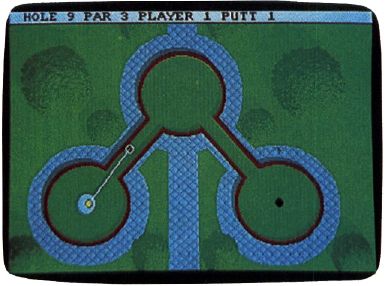HOLE-IN-ONE MINIATURE GOLF
Drive by any miniature-golf course and you'll see players tapping brightly colored balls through and around obstacles into that little hole. Most of us remember our first hole-in-one—the ball skittered past the windmill, banked off the wall, and fell into the cup. Who can forget winning their first free game, the shot skipping into the clown's mouth on the 18th hole?
DigiTek's Hole-in-One Miniature Golf brings back many of those memories and creates new ones with a tantalizing selection of courses, an extensive range of difficulty, and an accurate representation of plastic-turf physics. It gives you the changes in elevation found on modern courses and the simplicity of traditional miniature golf. Once you have the game figured out, DigiTek adds the Fantasy course, one that grew either from a nightmare or a hallucination.
You won't waste any time learning the joystick, mouse, or keyboard interface. A tutorial takes you through the basics, and in just a few minutes you're teeing up on the first hole. You place your ball, set your direction and power indicator, and then hope you've correctly figured the angles.
All of the available courses offer difficulties, but you can choose beginner, intermediate, or expert levels for each. Actually, there's little difference between the first two levels; then there's a jump in difficulty for advanced players.

Hole-in-One delivers some nifty options to the computer-golf scene. From the overhead view, elevation is indicated by shading. You can also view a hole's contours from four different angles: hole to tee, left, right, or forward. When you reach the harder courses, the views are extremely helpful in shot selection. A replay option lets you see the last shot, and during practice sessions you can retry putts that missed the mark.
Up to four players can compete in a stroke-play match. You can toggle between the difficulty levels as each player takes a turn, handicapping players of different caliber.
The first level of play is the Classics course. Here you'll find the wind-mill, the straight-uphill putt, and the single carom shot off a side wall. The holes carry a par of 2 or 3 and, once you've learned to judge the strength of your shots, are relatively easy to master.
The Intermediate course presents a different challenge as elevation is given a greater role, multiple twisting doglegs come into play, and the number of obstacles increases. You can usually figure out the hole the first time you play this course, but execution places great emphasis on combining the correct angle with the proper speed.
The upper-level courses are almost impossible to predict the first few times you play them. The Fantasy course is easier than the Expert, but it brings its own unique view. You'll play one hole upside down, putt into sewers, and discover bridges guarded by dragons on a hillside.
The game supports Hercules, Tandy 16-color, CGA, EGA, and VGA/MCGA graphics. The EGA and Tandy versions are clean and attractive. The VGA game takes full advantage of the 256-color palette, but it requires 384K of RAM. (The other graphics modes run with 256K.)
Hole-in-One Miniature Golf is a novel package with wide-ranging appeal. If you've been captivated by the magic of miniature golf on an actual course, you won't be surprised with the long hours you'll spend with this computer version.
MIKE HARRISON
|
Amiga—$39.95 DIGITEK SOFTWAREM |